02.18.05
Scientists have detected a flash of light from across the Galaxy so powerful that it bounced off the Moon and lit up the Earth's upper atmosphere. The flash was brighter than anything ever detected from beyond our Solar System and lasted over a tenth of a second. NASA and European satellites and many radio telescopes detected the flash and its aftermath on December 27, 2004. Two science teams report about this event at a special press event today at NASA headquarters. A multitude of papers are planned for publication.
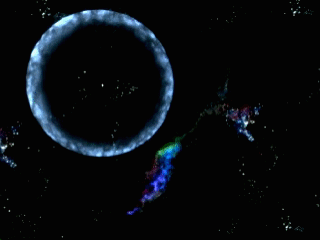
Image/animation above: Image 1: Artist conception of the December 27,
2004 gamma ray flare expanding from SGR 1806-20 and impacting Earth's
atmosphere. Credit: NASA
The scientists said the light came from a "giant flare" on the surface
of an exotic neutron star, called a magnetar. The apparent magnitude was
brighter than a full moon and all historical star explosions. The light was
brightest in the gamma-ray energy range, far more energetic than visible light
or X-rays and invisible to our eyes.
Such a close and powerful eruption raises the question of whether an even larger
influx of gamma rays, disturbing the atmosphere, was responsible for one of the
mass extinctions known to have occurred on Earth hundreds of millions of years
ago. Also, if giant flares can be this powerful, then some gamma-ray bursts
(thought to be very distant black-hole-forming star explosions) could actually
be from neutron star eruptions in nearby galaxies.
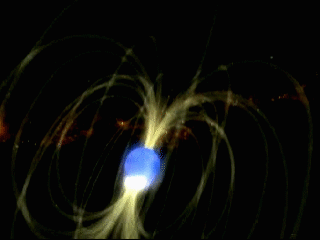
Image/animation above: Image 2: An artist conception of the SGR 1806-20
magnetar including magnetic field lines. After the initial flash, smaller
pulsations in the data suggest hot spots on the rotating magnetar's surface. The
data also shows no change in the magentar's rotation after the initial flash. Credit: NASA
NASA's newly launched Swift satellite and the NSF-funded Very Large Array (VLA)
were two of many observatories that observed the event, arising from neutron
star SGR 1806-20, about 50,000 light years from Earth in the constellation
Sagittarius.
"This might be a once-in-a-lifetime event for astronomers, as well as for
the neutron star," said Dr. David Palmer of Los Alamos National Laboratory,
lead author on a paper describing the Swift observation. "We know of only
two other giant flares in the past 35 years, and this December event was one
hundred times more powerful."
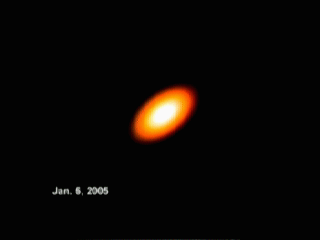
Image/animation above: Image 3: Radio data shows a very active area
around SGR1806-20. The Very Large Array radio telescope observed ejected
material from this Magnetar as it flew out into interstellar space. These
observations in the radio wavelength start about 7 days after the flare and
continue for 20 days. They show SGR1806-20 dimming in the radio spectrum. Credit:
NRAO/CfA/Gaensler & Univ.
of Hawaii.
Dr. Bryan Gaensler of the Harvard-Smithsonian Center for Astrophysics in
Cambridge, Mass., is lead author on a report describing the VLA observation,
which tracked the ejected material as it flew out into interstellar space. Other
key scientific teams are associated with radio telescopes in Australia, The
Netherlands, United Kingdom, India and the United States, as well as with NASA's
High Energy Solar Spectroscopic Imager (RHESSI).
A neutron star is the core remains of a star once several times more massive
than our Sun. When such stars deplete their nuclear fuel, they explode -- an
event called a supernova. The remaining core is dense, fast-spinning, highly
magnetic, and only about 15 miles in diameter. Millions of neutron stars fill
our Milky Way galaxy.
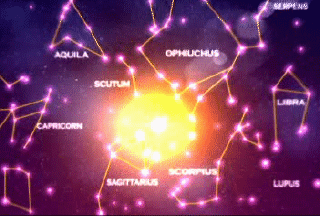
Image/animation above: Image 4: SGR-1806 is an ultra-magnetic neutron
star, called a magnetar, located about 50,000 light years away from Earth in the
constellation Sagittarius. Credit:
NASA
Scientists have discovered about a dozen ultrahigh-magnetic neutron stars,
called magnetars. The magnetic field around a magnetar is about 1,000 trillion
gauss, strong enough to strip information from a credit card at a distance
halfway to the moon. (Ordinary neutron stars measure a mere trillion gauss; the
Earth's magnetic field is about 0.5 gauss.)
Four of these magnetars are also called soft gamma repeaters, or SGRs, because
they flare up randomly and release gamma rays. Such episodes release about 10^30
to 10^35 watts for about a second, or up to millions of times more energy than
our Sun. For a tenth of a second, the giant flare on SGR 1806-20 unleashed
energy at a rate of about 10^40 watts. The total energy produced was more than
the Sun emits in 150,000 years.
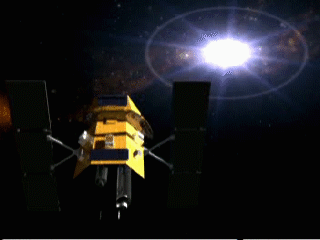
Image/animation above: Image 5: Swift is a first-of-its-kind
multi-wavelength observatory dedicated to the study of gamma ray burst (GRB)
science. Its three instruments will work together to observe GRBs and afterglows
in the gamma ray, X-ray, ultraviolet, and optical wavebands. Swift is designed
to solve the 35-year-old mystery of the origin of gamma-ray bursts. Scientists
believe GRB are the birth cries of black holes. Credit: NASA
"The next biggest flare ever seen from any soft gamma repeater was peanuts
compared to this incredible December 27 event," said Gaensler. "Had
this happened within 10 light years of us, it would have severely damaged our
atmosphere. Fortunately, all the magnetars we know of are much farther away than
this."
A scientific debate raged in the 1980s over whether gamma-ray bursts were star
explosions from beyond our Galaxy or eruptions on nearby neutron stars. By the
late 1990s it became clear that gamma-ray bursts did indeed originate very far
away and that SGRs were a different phenomenon. But the extraordinary giant
flare on SGR 1806-20 reopens the debate, according to Dr. Chryssa Kouveliotou of
NASA Marshall Space Flight Center, who took part in both the Swift and VLA
analysis.
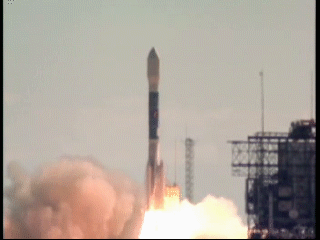
Image/animation above: Image 6: NASA's Swift satellite was successfully
launched Saturday, November 20, 2004 from the Cape Canaveral Air Force Station,
Fla. Credit: NASA
A sizeable percentage of "short" gamma-ray bursts, less than two
seconds, could be SGR flares, she said. These would come from galaxies within
about a 100 million light years from Earth. (Long gamma-ray bursts appear to be
black-hole-forming star explosions billions of light years away.)
"An answer to the 'short' gamma-ray burst mystery could come any day now
that Swift is in orbit", said Swift lead scientist Neil Gehrels.
"Swift saw this event after only about a month on the job."
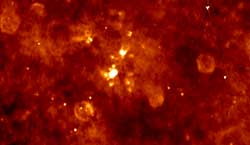
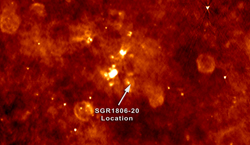
Image left: High resolution, wide-field image of the area around
SGR1806-20 as seen in radio wavelength, without a location arrow. Credit:
University of Hawaii. Image right: A high resolution, wide-field image of
the area around SGR1806-20 as seen in radio wavelength. SGR1806-20 can not be
seen in this image generated from earlier radio data taken when SGR1806-20 was
"radio quiet." The arrow locates the position of SGR1806-20 within the
image. Credit: University of Hawaii.
Scientists around the world have been following the December 27 event. RHESSI
detected gamma rays and X-rays from the flare. Drs. Kevin Hurley and Steven
Boggs of the University of California, Berkeley, are leading the effort to
analyze these data. Dr. Robert Duncan of the University of Texas at Austin and
Dr. Christopher Thompson at the Canadian Institute for Theoretical Astrophysics
(University of Toronto) are the leading experts on magnetars, and they are
investigating the "short duration" gamma-ray burst relationship.
Brian Cameron, a graduate student at Caltech under the tutorage of Prof. Shri
Kulkarni, leads a second scientific paper based on VLA data. Amateur astronomers
detected the disturbance in the Earth's ionosphere and relayed this information
through the American Association of Variable Star Observers (http://www.aavso.org).
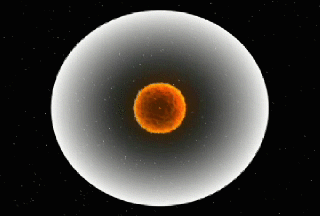
Image above: SGR 1806-20 is a "magnetar": a rapidly spinning neutron star that not only has an incredible density, trillions of times greater than ordinary matter, but an incredibly strong magnetic field. Tens of thousands of years ago, a "starquake" fractured the magnetar's surface. The result was an explosive release of energy, which sent a pulse of gamma rays racing across the cosmos at the speed of light. Behind them came the explosion's fireball, expanding in a lopsided fashion at roughly one-third the speed of light. The gamma rays swept past the Earth on December 27, 2004, when they were detected by NASA's Swift satellite. That initial signal faded away within minutes. But then came a steady stream of radio waves from the fireball. Astronomers rushed to ground-based radio telescopes such as NSF's Very Large Array outside Socorro, New Mexico, where they have been studying the information-rich signal ever since. Credit: NSF
http://www.nasa.gov/vision/universe/watchtheskies/swift_nsu_0205.html
Category: Perspective








